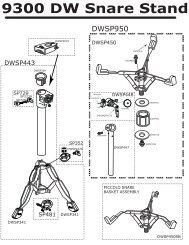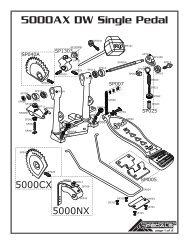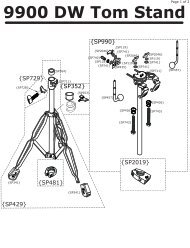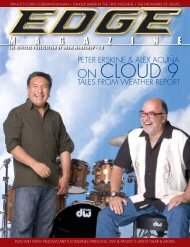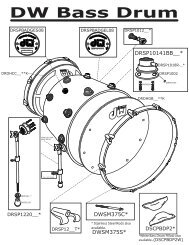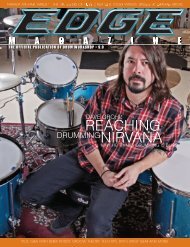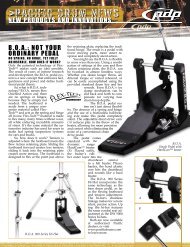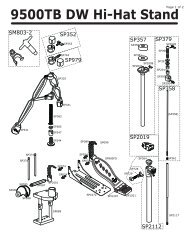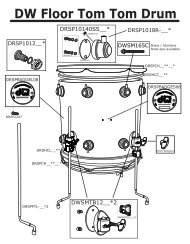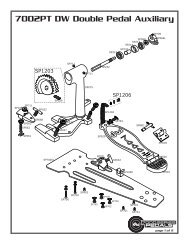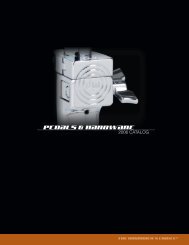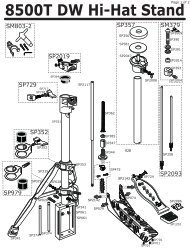Man these feel really really good. - Drum Workshop
Man these feel really really good. - Drum Workshop
Man these feel really really good. - Drum Workshop
You also want an ePaper? Increase the reach of your titles
YUMPU automatically turns print PDFs into web optimized ePapers that Google loves.
TIME MACHINE<br />
John Jr roBinSon:<br />
a career retroSPective<br />
By rich mangicaro<br />
I’ve known John JR Robinson for a while now. Four<br />
years ago, I had the distinct honor of signing him<br />
to his Paiste endorsement agreement. Ironically,<br />
this was one of the last major achievements that<br />
I enjoyed while working with the Swiss cymbal<br />
company, because shortly after that, I moved on<br />
from my career there to pursue my playing and<br />
writing full-time. Now, after all <strong>these</strong> years and<br />
most ironically, I’m once again experiencing an<br />
honor when DW asked me to interview John for<br />
his article in Edge. John and I have become <strong>good</strong><br />
friends over the years and while we’re colleagues<br />
in this business, I never loose sight of who this<br />
man is…and I’m continually humbled.<br />
Very few musicians have achieved what John has.<br />
Since he began his recording career back in the<br />
late 70’s, John Robinson has played on more hit<br />
recordings than just about anyone in the history<br />
of popular music. Just naming a few of them –<br />
“Rock With You”, “We Are The World”, “All<br />
Night Long”, “Back In The High Life”, “Change<br />
The World” – <strong>these</strong> songs are household titles…<br />
without even naming the artists. And the list<br />
goes on…and on. We sat down recently at DW to<br />
have a conversation about his big decision to leave<br />
the drum company that he was with for 28 years,<br />
why he did this and basically try to review his<br />
massive career, all within an hour! Through the<br />
magic of the Internet, you can find that interview<br />
on <strong>Drum</strong>Channel.com, by the way. You may find<br />
some little gems that don’t quite translate here in<br />
print. Don’t worry – we kept it clean!<br />
Rich <strong>Man</strong>gicaro: John, this is a major change for<br />
you and I know, one you thought very carefully<br />
about. When I found out, it seemed to make sense<br />
to me.<br />
John Robinson: I think the natural evolution<br />
of me being with DW is coming full circle<br />
because when I was a kid, I was playing<br />
maple, American drums. It’s great to be<br />
welcomed and made to <strong>feel</strong> like family, right<br />
out of the gate.<br />
RM: And they’re right around the corner from<br />
your house!<br />
JR: It is…I can roll outta the rack and in<br />
twenty minutes, I’m here!<br />
RM: Before we get into your history, I want to<br />
address this change. You had a long association<br />
with your previous drum family and I’m sure<br />
many would like to know how you came to this<br />
decision. I know you’re a very loyal guy and take<br />
your relationships very seriously.<br />
JR: You know, being with one company<br />
for almost 29 years and then leaving, is like<br />
a divorce. You get used to certain ways<br />
things are done and of course, I made a lot<br />
of great records on Yamaha drums. But, as<br />
life progresses and changes, both companies<br />
and artists grow and change and it was time<br />
for me. With DW, the question was how<br />
was my personality and soul going to come<br />
through with <strong>these</strong> drums. I just did a gig<br />
this past Saturday with David Foster for the<br />
Andre Agassi Foundation in Vegas and I had<br />
that Christmas morning anticipation. I got<br />
to sound check an hour early and hardly had<br />
to do anything to them…they just sounded<br />
amazing almost right away. On that gig, I<br />
was playing with Lionel Richie, Macy Gray,<br />
Tim McGraw, Daughtry and Cherise, so there<br />
was this huge variety of styles and everybody<br />
said that I sounded better than ever.<br />
RM: You know, I’ve known both John Good and<br />
Don Lombardi for a long time and have enjoyed<br />
watching their success. You’ve known them as<br />
well for some time, right?<br />
JR: Yes…I’ve known John for a long time<br />
and as you know, when you walk into his<br />
office, it’s filled with beautiful, raw shells<br />
and different exotic woods. I’m a wood guy<br />
so I just love that. We’re the same age, have<br />
similar concepts and we both like football!<br />
Everything translates into <strong>these</strong> drums. It’s<br />
been <strong>really</strong> nice to exchange ideas and then<br />
realize that we’re on the same page.<br />
RM: So you’re originally from Iowa. What was<br />
it like growing up in a small town? Was there<br />
any kind of a music scene?<br />
JR: I was young so the scene was my Dad<br />
would wail on me when I didn’t practice<br />
piano! He was very musical as was my Mom<br />
and both my Grandfathers as well. I also<br />
have cousins that play but I was the one who<br />
was crazy enough to try to make a living<br />
out of it. Mom taught me what Swing was,<br />
the concept of it and pointed out examples<br />
on recordings. What got me though was a<br />
45 I had of “When The Saints Go Marching<br />
In”, from a film about Red Nichols featuring<br />
Danny Kaye. I was 7 and I played that over<br />
and over and wore it out. That led me to my<br />
first drum set when I was 8. It was a 1940’s<br />
Ludwig kit, no Toms, just a snare, bass drum,<br />
hi-hat and old Zildjian cymbal. I wasn’t even<br />
holding the sticks correctly but I played a<br />
swing beat, right away.<br />
RM: Were you in school music programs?<br />
JR: Eventually. When I was 10, I met a guitar<br />
player through my parents and we had a duo<br />
photos by Rob Shanahan<br />
that played and opened for older aged bands.<br />
I studied snare drum and also sang in church,<br />
which I think helped with my drumming.<br />
Then in Jr. High, there were two drummers<br />
ahead of me, a few years older and I finally<br />
got the chance to play. I made a lot of mistakes<br />
reading the chart but the band director, Dick<br />
Bauman thought my <strong>feel</strong> was much better<br />
than the other two guys and I finally got my<br />
reading together. Then during High School,<br />
I played in bands and went to Jazz band<br />
camps during the summers. That’s when I<br />
met Ed Soph. At that time, I was trying to<br />
decide whether to pursue a career in music<br />
or basketball…I had an offer for a basketball<br />
scholarship but finally decided that I wanted<br />
to make a career of music. It was Ed who<br />
inspired me to choose the Berklee College of<br />
Music in Boston.<br />
RM: So, who was else was at Berklee when you<br />
were there?<br />
JR: Whew! In Gary Chaffee’s class was<br />
Steve Smith, Kenwood Dennard and Vinnie<br />
Colaiuta! That class was intense.<br />
RM: Would you say that Gary was your<br />
predominant influence?<br />
JR: Actually, it was Alan Dawson. I was very<br />
fortunate to get 6 months in with Alan. I<br />
think between my Ed Soph education and<br />
Alan’s, it’s all melody-based. With Ed, he<br />
changed me from a toe bass drum player to<br />
a heel-down player. That took a couple of<br />
years to do.<br />
RM: For melodic reading, was it with mallets or<br />
piano?<br />
JR: It was mallets and at that time, I wasn’t<br />
allowed to use piano as my minor instrument<br />
and I was distraught about that. I wanted to<br />
have piano under my belt, but at that time,<br />
mallets were what they viewed as the way<br />
for drummers to learn melodic reading. But I<br />
did end up studying with Dave Samuels and<br />
we became friends and did gigs together as<br />
well.<br />
RM: So you were giggin’ all the time during<br />
Berklee?<br />
JR: Always. Although there weren’t many<br />
gigs at that time, I began playing around<br />
town. Also, there was only one studio at<br />
Berklee at that time and I ended up getting<br />
asked to replace some drum parts on some<br />
music-minus-one stuff and I didn’t even<br />
know what a click was! They pulled up the<br />
track and I played to it. It must have went<br />
well, because they asked me to come back<br />
every week at that time to work with them<br />
and I became the studio drummer. There<br />
were a couple of “famous” drummers at that<br />
time, that will go un-named that I replaced,<br />
who couldn’t play to the<br />
click.<br />
RM: As you know, John<br />
– it’s not something that<br />
every drummer can do<br />
well. Not only to play with<br />
the click, to lock with it, but<br />
also to play musically with<br />
it.<br />
JR: Well that’s it. I think<br />
then, I realized that I<br />
wanted to be a studio<br />
drummer. My plan was<br />
to get through Berklee<br />
and then move to New<br />
York. I was in my 3rd<br />
year and then left to just<br />
focus on working.<br />
RM: Is this when Rufus found you?<br />
JR: I was in a band called “Shelter”, touring<br />
around the Northeast and Midwest and one<br />
time, in Cleveland, Rufus came with Chaka<br />
into the club we were playing. At the end of<br />
the set, they asked if they could sit in with<br />
me. By the end of the night, that entire band<br />
was up on stage with me and we did an<br />
entire set…and it was smokin’! Four weeks<br />
later, I was in Los Angeles and in that band.<br />
RM: So you began touring with them?<br />
JR: They were on an international tour and<br />
my first gig was in Hawaii! That’s were<br />
I met Danny Seraphine! I had always<br />
idolized Danny, with the Midwest connect,<br />
the Chicago records…now we’re golfing<br />
buddies!<br />
RM: So did you record with them right away or<br />
was there touring work first?<br />
JR: We toured for about a month…I finished<br />
out their ’78 tour, before I went in the studio<br />
with them. I ended up doing quite a few<br />
records with them.<br />
RM: Your drum part for “Ain’t Nobody” is<br />
<strong>really</strong> great…I’ve heard you talk about that in<br />
some of your clinics.<br />
JR: <strong>Man</strong>y think it was a programmed part,<br />
but it was me playing that groove. It’s a<br />
very robotic part, which is what we were<br />
going for. It was a big hit for them.<br />
RM: And that was around the time period when<br />
you met Quincy Jones?<br />
JR: I had met him before that, but he then<br />
came in to produce one of our records. Not<br />
long after that, I got the call to work with<br />
Quincy on Michael Jackson’s “Off The Wall”<br />
record.<br />
RM: Did you have any idea of what you were<br />
getting into, at that time?<br />
It seems like that record<br />
was Michael’s transition<br />
between his Jacksons<br />
era and his solo superstardom.<br />
JR: And Quincy is the<br />
great master of that. He<br />
<strong>really</strong> brought Michael<br />
“Working with John<br />
and this company<br />
is so exciting and<br />
when you hear<br />
their drums and see<br />
what goes into it all,<br />
there’s no question<br />
why they’re the<br />
leader. ”<br />
>time machine: Jr roBinSon<br />
to the enormous place. The timing of all<br />
this was amazing. All the players on that<br />
album were stellar including my old band<br />
mates from Rufus and Paulinho Da Costa on<br />
percussion. That record changed history.<br />
RM: It seems that it<br />
changed your career…<br />
you’ve been working<br />
constantly since. Since<br />
space in this article doesn’t<br />
permit to thoroughly cover<br />
your discography, although<br />
what article would, I love<br />
how you’ve organized<br />
your recording credits by<br />
year, on your website. I<br />
recommend our readers to<br />
check that out. It’s quite<br />
incredible.<br />
JR: <strong>Man</strong>, I’m trying to<br />
remember ‘em all. I’m<br />
still trying to organize<br />
and catalog it all. I still<br />
haven’t figured out Asia<br />
or Europe!<br />
RM: One has to wonder whether you ever had a<br />
social life back then. Tell me about a typical day,<br />
when you were recording so much. You were<br />
doing 3 sessions in one day. Was this also when<br />
cartage services began to take affect?<br />
JR: Exactly. I had Rufus’ roadie<br />
helping me. I had heard storied then<br />
about Steve Gadd doing this type of<br />
schedule too. It was typically a 10am,<br />
2pm and a 6pm. Sometimes, we’d<br />
even have an 11pm hit too. Those<br />
were the hay days of recording and<br />
LA was just flowering. That’s why<br />
I loved Jeff (Porcaro) so much…he<br />
was very kind to me when I came to<br />
LA and we found ourselves sharing<br />
the load on many records. Now,<br />
our industry’s changed so much<br />
that there are very few record dates<br />
anymore that feature a rhythm<br />
section, playing live, like back then.<br />
I still get called for that, especially for<br />
film soundtrack sessions, but it’s the<br />
reason why I and many other guys<br />
have built studios in our homes.<br />
RM: John, will<br />
all the great<br />
hit records that<br />
you’ve played on,<br />
do you have any<br />
favorites?<br />
JR: Well, Steve<br />
W i n w o o d ’ s<br />
“Higher Love”<br />
and “Back In The<br />
High Life” were both incredible and they<br />
allowed me to do what I wanted. It’s very<br />
rare that we get to do that and producer<br />
Russ Titelman <strong>really</strong> gave me the freedom to<br />
express. That whole record was great.<br />
RM: John, what would you say to young players<br />
out there, given the current state of our business,<br />
who are trying to get in and make something for<br />
themselves?<br />
JR: I just wrote a curriculum for Berklee<br />
about this. I’ve always had some kind of<br />
home studio so I <strong>feel</strong> it’s always important<br />
for drummers to control their own destiny.<br />
I say always collaborate and co-write with<br />
others. Log your ideas and learn electronics…<br />
not just electronic drums but learn a protools<br />
rig, know your Mac and know how to<br />
mic your drums and learn what mics work<br />
best for what drum. I also wanted to say<br />
something about my new association with<br />
DW. My new drum set is extraordinary.<br />
Working with John and this company is so<br />
exciting and when you hear their drums and<br />
see what goes into it all, there’s no question<br />
why they’re the leader.<br />
Selected diScograPhy:<br />
2009 Barbra Streisand: The Concerts<br />
2004 Peter Cetera: You’re the Inspiration: A Collection<br />
2002 Quincy Jones: Ultimate Collection<br />
2002 Celine Dion: Unison / Celine Dion / Colour Of My Love<br />
2001 Bonnie Raitt: Nine Lives-Remastered<br />
2000 Mariah Carey: Rainbow (Bonus Track)<br />
2000 Babyface: Collection of His Greatest Hits<br />
1999 Dave Koz: Dance<br />
1999 Clint Black: D’Lectrified<br />
1999 Chris Botti: Slowing Down the World<br />
1998 David Foster: Touch of David Foster<br />
1998 Randy Newman: Guilty: 30 Years of Randy Newman<br />
1998 Luis Miguel: Todos Los Romances<br />
1998 Joe Cocker: Greatest Hits [EMI]<br />
1998 Steve Perry: When You’re in Love (For the First Time)<br />
1998 Bette Midler: Bathouse Betty<br />
1997 Stanley Clarke: Bass-ic Collection<br />
1997 Ladysmith Black Mambazo: Heavenly<br />
1997 Joe Cocker: Across from Midnight<br />
1997 Boz Scaggs: My Time The Anthology (1969-1997)<br />
1997 Vonda Shepard: Vonda Shepard<br />
1996 Karen Carpenter: Karen Carpenter<br />
1996 Neil Diamond: In My Lifetime<br />
1996 Disney: Music from the Park<br />
1996 Rufus & Chaka Khan: Very Best of Rufus Ftg Chaka Khan<br />
1995 Peter Frampton: Frampton Comes Alive II<br />
1994 The Temptations: Emperors of the Soul<br />
1993 Elton John: Duets<br />
1992 Wilson Phillips: Shadows & Light<br />
1992 <strong>Man</strong>hattan Transfer: Anthology: Down in Birdland<br />
1992 Kenny G: Breathless<br />
1992 Mike Oldfield: Tubular Bells II<br />
1991 Rod Stewart: Vagabond Heart<br />
1991 Jeff Lorber: Worth Waiting For<br />
1991 Patti LaBelle: Burnin’<br />
1991 Robbie Robertson: Storyville<br />
1991 Tom Scott: Keep This Love Alive<br />
1989 Aretha Franklin: Through the Storm<br />
1988 Rubén Blades: Nothing But the Truth<br />
1988 Glen Fry: Soul Searchin’<br />
1987 Michael Jackson: Bad<br />
1986 Steve Winwood: Back in the High Life<br />
1986 Bob Seger: Like a Rock<br />
1985 David Lee Roth: Crazy from the Heat<br />
1984 Laura Branigan: Self Control<br />
1984 Fee Waybill: Read My Lips<br />
1984 Peabo Bryson: Straight From the Heart<br />
1981 Herb Alpert: Magic <strong>Man</strong><br />
1979 Rufus: Numbers<br />
[eDGe 8.0] 7



